Junipers aren’t as forgiving as some plants when it comes to pruning. Do the job the wrong way and you’ll end up with an ugly skeleton of a shrub with bald spots and bare branches.
On the bright side, junipers don’t generally need much in the way of pruning, with a few exceptions.
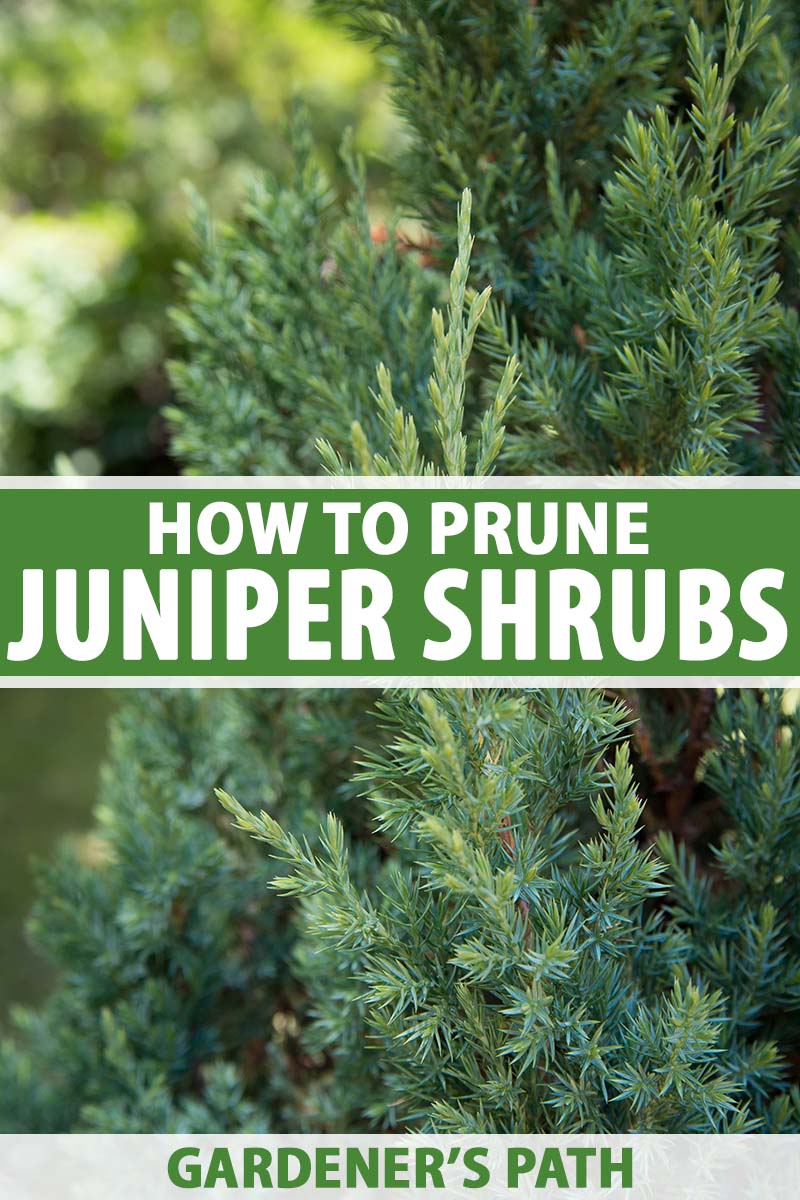
We link to vendors to help you find relevant products. If you buy from one of our links, we may earn a commission.
While these plants are notoriously low maintenance, when trimming up is necessary, it’s important to do it right. We’ll talk about the how and the when in this guide.
Here is what’s ahead:
What You’ll Learn
If you’re ready to shape things up, get those pruners ready and let’s go!
The Goal of Pruning Junipers
First, let’s get the bad news out of the way. If you’re hoping to reduce the size of your juniper rather than providing some shape, pruning isn’t going to work very well.
The goal of taking the trimmers to your plant is to encourage bushier growth, remove dead wood, or create some shape. Otherwise, junipers generally don’t need to be pruned at all.
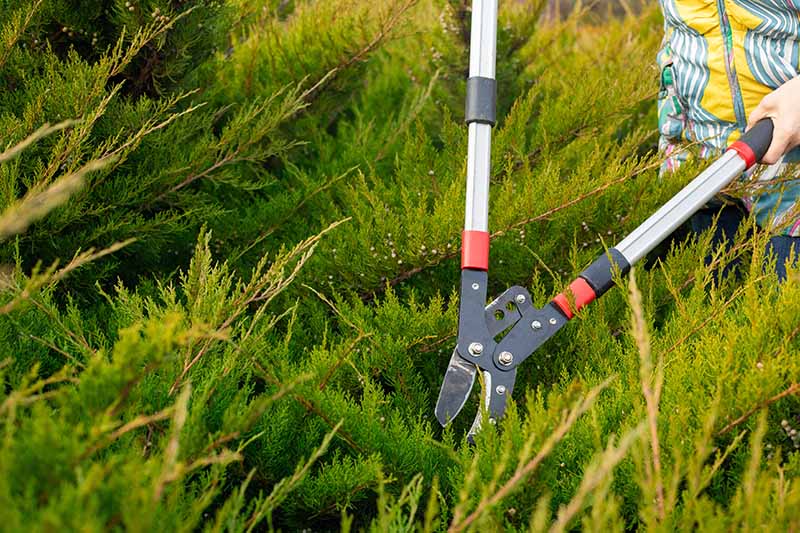
Now, if you want to shape your shrub into a topiary or other formal shape, that’s a different subject. That requires some pretty regular pruning and shaping.
What we’re talking about is rejuvenation pruning of neglected plants with dead branches, or performing routine maintenance.
While we’re on the topic, if you have a bush or tree that is bursting out of its spot or that keeps grabbing you as you try to walk past it on the sidewalk, your best bet is to dig up the plant, transplant it elsewhere, and replace it with something smaller.
Trimming won’t keep it small and the plant will never look as good, nor grow as healthy, as it should.
Some species like boxwoods can be kept smaller through pruning and they’ll still be healthy, but junipers just aren’t one of those plants.
When to Prune
Technically, as long as the temperature isn’t below freezing, you can prune at any time of year. Pruning when it’s below freezing can seriously damage or even kill the plant.
Avoid doing the job in the fall, since this can increase the chance of incurring winter damage.
Early spring or late winter is best. You want to try to break out the secateurs before the tender new growth forms. It’s healthier for the plant and looks better, to boot.
How to Prune
The method you’ll use depends on the size of the branch you are cutting. Small branches that are the same diameter or smaller than a pencil can be snipped with a pair of secateurs, while slightly larger branches can be cut with pruners.
Whichever you use, don’t cut beyond the branch collar. This is a slightly raised spot at the base of where the branch meets the trunk.
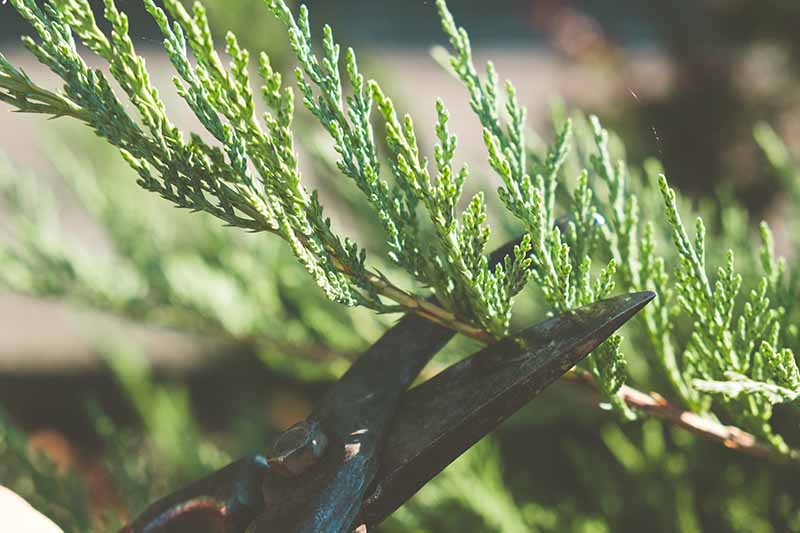
Large branches should be trimmed with a saw using a three-step method, as follows.
1. First, saw halfway through the underside of the branch a few inches out from the trunk.
2. The second cut should be made from the top side. About half an inch out from the lower cut, saw down through the branch about halfway at an angle, so you meet your undercut. The whole thing should now come away cleanly.
3. Finally, saw away the remaining stump, taking care not to cut past the branch collar. This prevents the weight of the branch from breaking it off as you cut.
If you trim back a branch beyond where the needles are growing, hoping to encourage branching, it won’t work. Junipers form needles at the green tip of branches, and old wood won’t form new needles.
If you need to trim a branch back past the point where the needles are, remove it entirely.
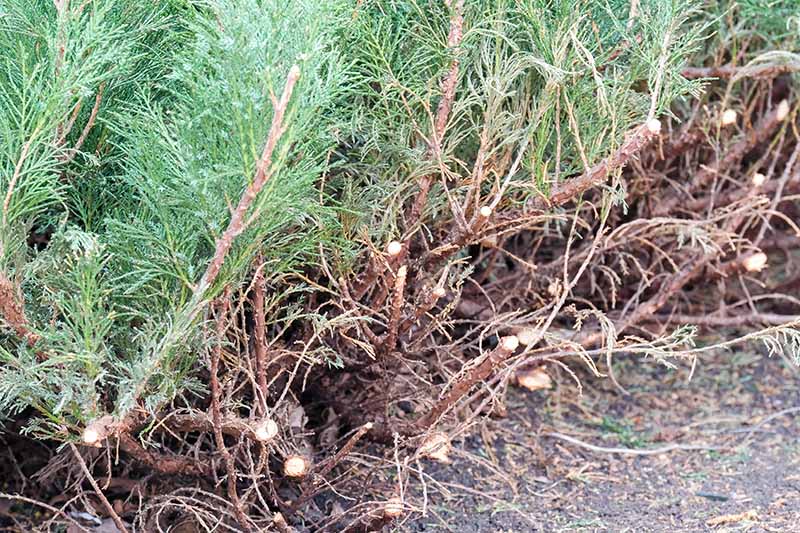
You should also remove any branch that doesn’t have needles on it. Remember, it will never start growing new foliage.
Regardless of how many branches you remove from the plant, avoid pruning the central trunk, which is known as the leader. A healthy evergreen has one central trunk that the rest of the growth emerges from.
Plants with multiple leaders tend to be weaker and are susceptible to damage from wind and heavy snow. If your plant is young and has more than one central leader, remove all but one of them.
Remember that junipers are slow growers, so don’t prune too much all at once. This is particularly true of plants in growing shadier spots. Anything more than a quarter of the plant at a time is too much to trim.
There’s no need to seal the end of the cuts. The bush will do that itself, with the resin that flows inside the plant.
Encouraging Bushier Growth
If your goal is to encourage bushy growth, there are a few things to keep in mind.
First, shearing the plant isn’t the way to go about it. Not only can this create dead spots, but it creates a thick outer layer of foliage that shades the interior.
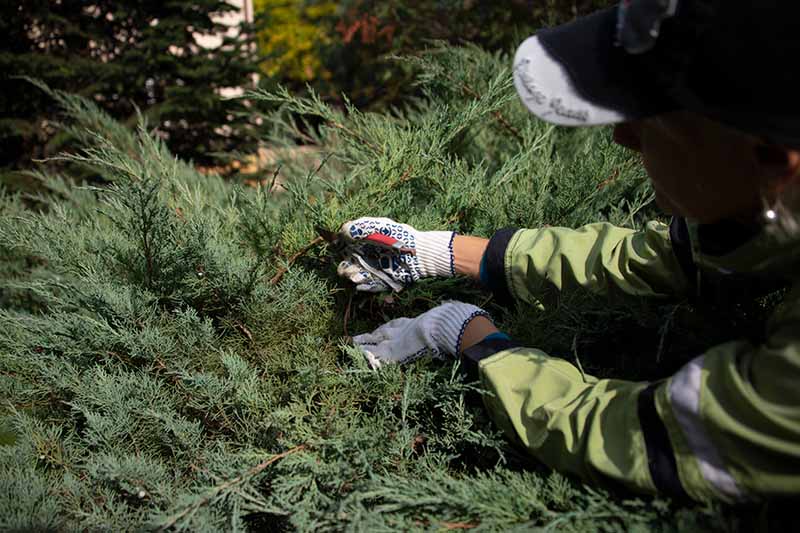
New foliage emerges from the tips of the branches, so the only way to encourage bushier growth is to trim the young, green ends.
The most natural-looking way to do this is to clip individual green tips with a pair of secateurs rather than shearing the entire plant.
Shape Up Your Juniper Shrubs
Junipers don’t need much in the way of pruning, but when they need it, it’s important to do it the right way. Hopefully, now you feel armed to trim your plants into top shape.
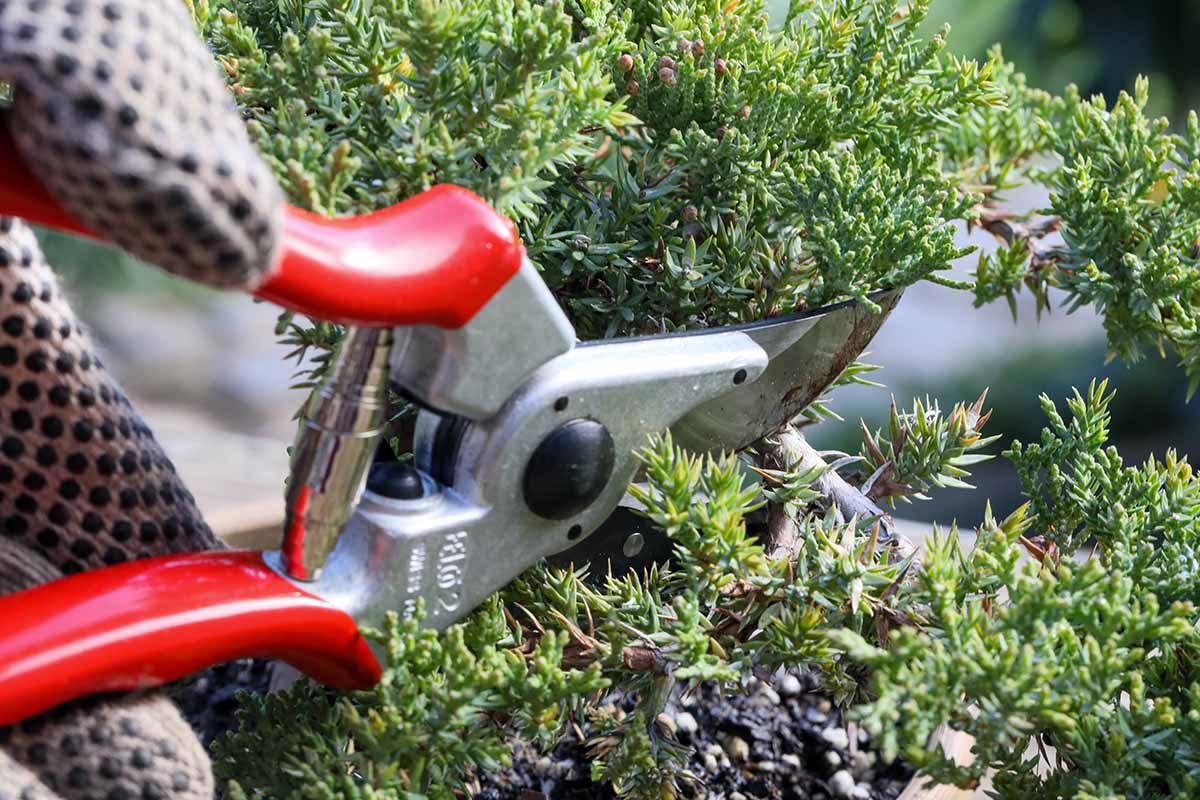
Let us know in the comments if you run into any trouble. We’re always here to help!
By the way, if you want to learn more about plants in the Juniperus genus, we have a few other guides that might be useful for you, including:


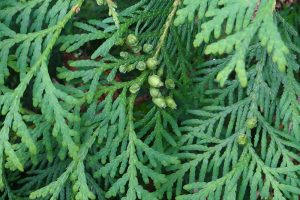
Thank you , I visited several sites and this was by far the most helpful.
Thank you for letting us know! I’m so glad you found our guide helpful, that makes my day.
I have several goldsturm(?) junipers as foundation plants that are very leggy, almost like trees, and they are very unattractive. If I cut them almost to the ground there will be no foliage left. Will they re-grow?
Hi Martha! Sadly, no. Your shrubs won’t grow back if you cut them to the ground. They also won’t develop new branches if you cut them back past the bare wood areas. That’s one of the drawbacks of junipers. Once they become leggy and tree-like, it’s difficult to return them to a nice shape. The best you can do is prune the existing foliage by about a third to encourage bushier growth.
Hi! I just moved to a home where the juniper branches are HEAVY on my fence. Previous owner did not cut back… I started on a couple trees and then found your blog. It’s below freezing a couple nights here in Greenville, SC, and I’m worried I may have killed the trees since I started doing this in Dec. Yikes! I’ll hold off on rest until spring. Thanks!
Don’t worry too much, junipers are pretty resilient. It’s unlikely that you killed the plant though you might have shocked it a little. Good idea to hold off, though. In late winter or early spring, you can pick back up with a little more pruning. Just be careful not to prune back to the part of the branch that is bare of needles. The plant won’t branch out, and you’ll be left with a dead spot.
Thank you for the informative, albeit bad news. I have a hedge of junipers next to a sidewalk and they are starting to encroach so I wanted to prune them back. I was googling around trying to find the best time of year to prune so that the dead spots from pruning would quickly fill back in. Thank goodness I read your article first… What I am reading here is that it would NEVER fill back in the dead spot and I need to prune entire branches so as to encourage new branches growing in what will be the area… Read more »
I have 1 dead “pom” on my juniper pom-pom (6 poms) tree, can I cut it off at the trunk or just under the dead pom branch?
Hi there, cut it back to the trunk. If you cut it under the dead pom, it will stay a dead stump with no green. You should never cut past living leaves.
The leader on my juniper tree has died. Should I trim it off?
Hi Julie, if it’s completely dead, you should remove it. Junipers won’t regenerate new growth on a dead branch.
Should dead needles be removed from beneath Juniper trees and bushes or left to decompose?
Hi Kristine, I am wanting to shape overtime a conical growing gin fizz juniper into a fairly straight hedge. can i do this by trimming regularly the new growth and can I remove the leader when it gets to my optimum height of 7 ft. I am trying to shape a formal hedge out of newly bought conical junipers. Thanks
Hi Hugh, yes, you should be able to trim the leader and then encourage thicker lateral growth. Just remember not to cut the leader back into bare wood, or you’ll end up with a naked spot on top. Cut the leader when it reaches the right height and is still green and flexible.
My junipers have gotten out of control I was sick for a few years and didn’t get them pruned they are about 5 ft tall and about 7-8 ft around way to big for the front of our house can I trim them down to a manageable size? and when should I do this? Was thinking about just making them a rounded or a flat top bush ? thanks
Hi Mike, I’m sorry to hear that. You can trim them back, but you’ll need to do it slowly over time. In the spring, take the growth back just in front of any bare wood. Don’t cut so far back that you hit bare wood or that stem won’t put out any new growth. You can cut a juniper pretty severely so long as you aren’t cutting into bare wood. Still, try not to take out more than half to a third of the plant at a time.
Kristine, I’m so glad I found your article before picking up my secateurs. I have a couple of massive juniper shrubs that are so huge, old, and gnarly that they look like oversized bonsai on steroids. I adore their gnarly look, with their artfully distorted branches lurking around under a vigorous canopy of vibrant needles. Unfortunately, they are encroaching on the sidewalk. I need to rein them in, and now I know how. Thanks! (If they weren’t so large, I’d have them transplanted so they could unfold freely into their full potential.)
Hi Lisa, I’m so glad I was able to help! They sound incredible, I don’t blame you for wanting to preserve them.